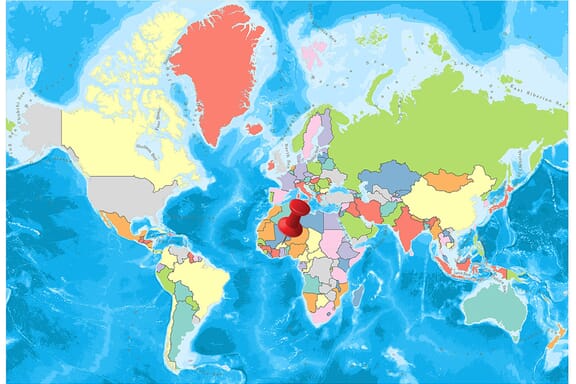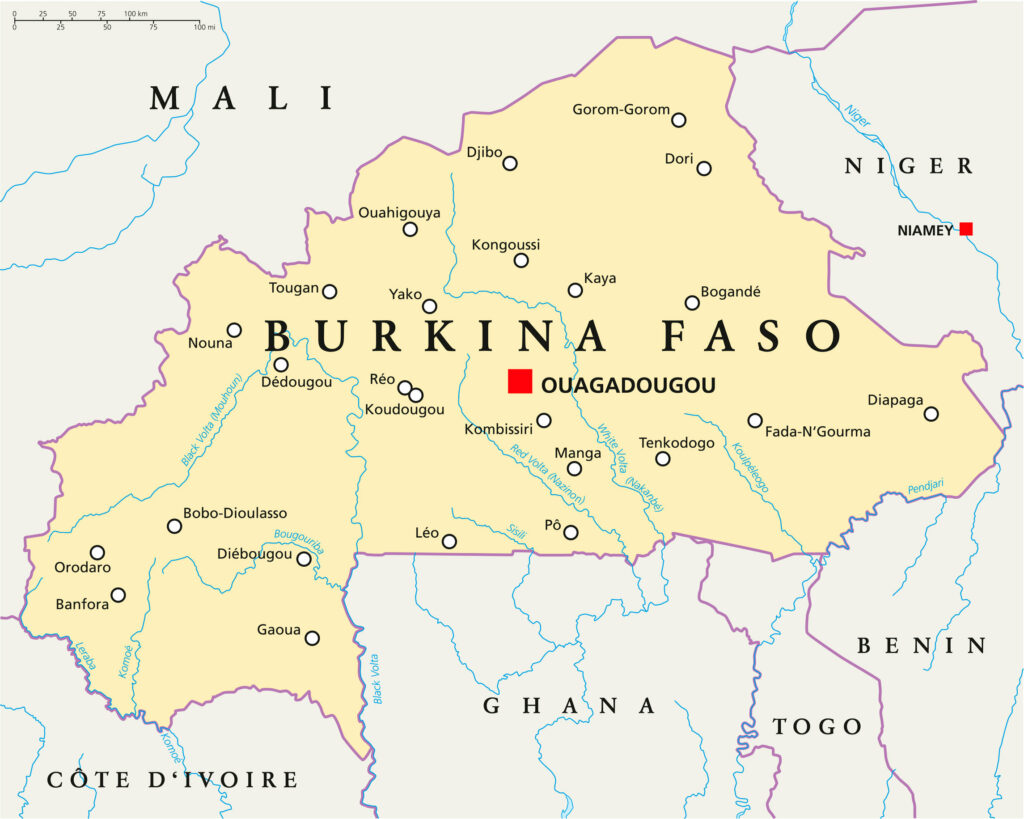Burkina Faso is located in the Northern Africa region at latitude 12.238333 and longitude -1.561593 and is part of the African continent.
The DMS coordinates for the center of the country are:
- 12° 14' 18.00'' N
- 1° 33' 41.73'' W
You can see the location of Burkina Faso on the world map below:

Burkina Faso Neighboring Countries
The neighboring countries of Burkina Faso (BF) are:
- Benin (BJ)
- Cote d’Ivoire (CI)
- Ghana (GH)
- Mali (ML)
- Niger (NE)
- Togo (TG)
Burkina Faso is a landlocked country, which means it does not have direct access to the open ocean.
Burkina Faso Related Content
Burkina Faso Key Facts
| Country | Burkina Faso |
| Coordinates | Latitude: 12.238333 Longitude: -1.561593 |
| Country Codes | Alpha 2: BF Alpha 3: BFA |
| Country Flag Emoji | 🇧🇫 |
| Int. Phone Prefix | +226 |
| Capital city | Ouagadougou |
| Continent Subcontinent | Africa Northern Africa |
| Country Area | 274,200 sq km |
| Population 2021 | 21,497,097 World Rank: 58 |
| Median Age | 16.6 |
| Life expectancy | 59.3 |
| Major languages | French (official), native African languages belonging to Sudanic family spoken by 90% of the population |
| UTC/GMT Time | Number of time zones: 1
|
| Internet TLD | .bf |
| Biggest Airport | Ouagadougou Airport (OUA) |
| Average temperature | 28.29 °C 82.92 °F |
| Administrative Divisions | 13 regions 45 provinces |
| Political system | Presidential representative democratic republic |
Burkina Faso Economy Facts
| World Bank Income Group | Low income |
| World Bank Region | Sub-Saharan Africa |
| Currency | CFA Franc (XOF) |
| GDP in 2020 | $17.9 (billions of USD) World Rank: 117 |
| GDP per capita in 2020 | $858 World Rank: 174 |
| Major Industries / Economic Sectors | Agriculture, mining, manufacturing, energy |
| Top 5 Import Countries | China, Côte d'Ivoire, India, Netherlands, France |
| Top 5 Export Countries | China, India, Netherlands, Turkey, France |
Biggest Cities in Burkina Faso
Here are the largest cities in Burkina Faso based on 2021 data:
| City | Population |
|---|
| Ouagadougou | 2,453,496 | Bobo-Dioulasso | 903,887 | Koudougou | 160,207 | Ouahigouya | 124,580 | Kaya | 122,949 | Banfora | 117,200 | Pouytenga | 99,950 | Hounde | 87,154 | Fada Ngourma | 73,200 | Dedougou | 63,617 |
Map of Burkina Faso with the Largest Cities
Other Countries in the Northern Africa Region
- Where is Algeria?
- Where is Benin?
- Where is Cabo Verde?
- Where is Cameroon?
- Where is Chad?
- Where is Comoros?
- Where is Djibouti?
- Where is Egypt?
- Where is Equatorial Guinea?
- Where is Eritrea?
- Where is Ethiopia?
- Where is Gabon?
- Where is Gambia?
- Where is Ghana?
- Where is Guinea-Bissau?
- Where is Guinea?
- Where is Ivory Coast (Côte d’Ivoire)?
- Where is Liberia?
- Where is Libya?
- Where is Mali?
- Where is Mauritania?
- Where is Morocco?
- Where is Niger?
- Where is Nigeria?
- Where is Sao Tome and Principe?
- Where is Senegal?
- Where is Sierra Leone?
- Where is Somalia?
- Where is Sudan?
- Where is the Central African Republic?
- Where is Togo?
- Where is Tunisia?
Geography
Burkina Faso is located to the north of Ghana in West Africa, south of the Sahara desert. Its surface area is 274,200 km².
Map of Burkina Faso

Burkina Faso Key Facts
The borders and their length of Burkina Faso are:
- Benin 306 km
- Côte d’Ivoire 584 km
- Ghana 548 km
- Mali 1,000 km
- Niger 628 km
- Togo 126 km
Most of the country consists of a large plateau covered with a lateritic rock layer dominated by eroded heights. Sandstone plateaus in the southwest are bounded by Banfora rocks.
The lowest point is the Mouhoun (Kara Volta) River 200 m. The highest point is Tena Kourou 749 m. Its natural sources are manganese, limestone, marble, small gold mines, antimony, copper, nickel, bauxite, lead, phosphate, zinc, silver.
Governance
Burkina Faso is governed by a multi-party democratic republican regime. The head of state is the president and the head of the government is the prime minister. The legislative power is in the 107-member parliament. Members of Parliament are elected by free general elections.
Burkina Faso is a member of the UN, OIC (Organization of Islamic Conference), African Union, Economic Community of West African Countries, IMF (International Monetary Fund) and Islamic Development Bank.
Climate
The climate in the country varies by region. There is a desert climate in the north, a tropical climate in the middle and a slightly more rainy climate in the south. In the March-May period when the weather warms, the temperature reaches up to 40 degrees. The weather is usually dry.
Drought sometimes affects life significantly. In the capital, the average annual temperature is 29 degrees, and the average annual rainfall is 884 mm.
Religion
The proportion of those who believe in local ethnic religions throughout Burkina Faso is still high. The proportion of those who believe in local religions is around 15%. In the local religion of the Mossis, Wende, who is considered to be God, has the belief that he has returned to the world as a human being after creating the world. It is believed that the god in question is present in different places and in different places in the world in different periods.
The long-lasting resistance of Islam across the country has been broken as a result of King Moogo Naaba Doulgou’s choice of Islam and an increase in the proportion of those who maintain their lives according to Islamic beliefs throughout the country.
Islam is the dominant religion in the country today, 60.5% of the population lives according to this belief. The percentage of those who believe in the Christian religion is 23.2%, while the proportion of Christians belonging to the Catholic sect is 19% and that of the Protestant sect is 4.2%.
Industry and Tourism
Burkina Faso is one of the poorest countries in Africa. It has a high population density, a small number of natural resources and a weak soil. The majority of the population is engaged in agriculture.
The industry is dominated by unprofitable state-controlled institutions. After the devaluation of the African Franc in January 1994, the government renewed its development program with international agencies and increased exports and economic growth.
The conservation of the country’s macroeconomic development depends on low inflation, the downturn in the trade deficit and the continuation of reforms to promote private investment.
Art
60 different ethnic groups living within the boundaries of Burkina Faso are rich in cultural traditions. Celebrations and ceremonies are held in the groups for many reasons and many visual feasts such as music, dance, and masks are exhibited in these celebrations and ceremonies.
In these regions, the gray tombs, known as the people who tell the oral history and traditions of the tribes from generation to generation, play an important role. These people can also take part in the celebration and entertainment as a singer and dancer.
Handicrafts also have an important place throughout the country, and pottery, basket making, and bronze woodworking are often handicrafts.
Sports
Burkina Faso is the national football team representing Burkina Faso in the international arena. In the tournament the team first joined in 1978, it was not able to show the success of staying in the finals and was always eliminated.